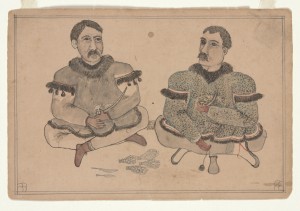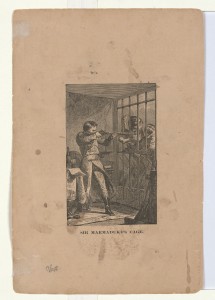Drawing E
Two men in different clothing with carved pipes
Notes on content:
Elizabeth Hutchinson (instructor): These two men wear different style parkas and boots from each other. They might be men from different villages or non-indigenous communities who are speaking with one another during the feast, though their faces are not typically Inupiaq. Each man holds a tobacco pipe in front of the center of his chest, wrapping the bowl with his fingers and there is a tobacco bag in front of the man at right. The pipes do not appear to be elaborately carved or decorated, but their presence is central to this scene, conveying the significance of an encounter between the two men.
According to Margaret Bruchac of the Penn Museum, this pipe shape indicates the connection between Inupiat peoples of Alaska and the Sami in Asia and their implication in the China trade, as the shape is one that exists on both sides of the Bering Strait and may have initially derived from pipes used for opium. Sean Asiqłuq Topkok says instead that these are churchwarden pipes and that they may reflect a different kind of exchange–with gold miners.
Notes on form/style:
Elizabeth Hutchinson (instructor): In addition to the pencil and pen work that is evident in most of the drawings, this piece uses ink wash to give the two parkas and one pair of boots additional color. This serves to further distinguish the two men. While they are less highlighted, the artist has taken care to include a few personal objects in front of each man. A viewer who had attended this feast would probably be able to recognize the men depicted from the details recorded with such care.
On the verso:


Leave a Reply
You must be logged in to post a comment.